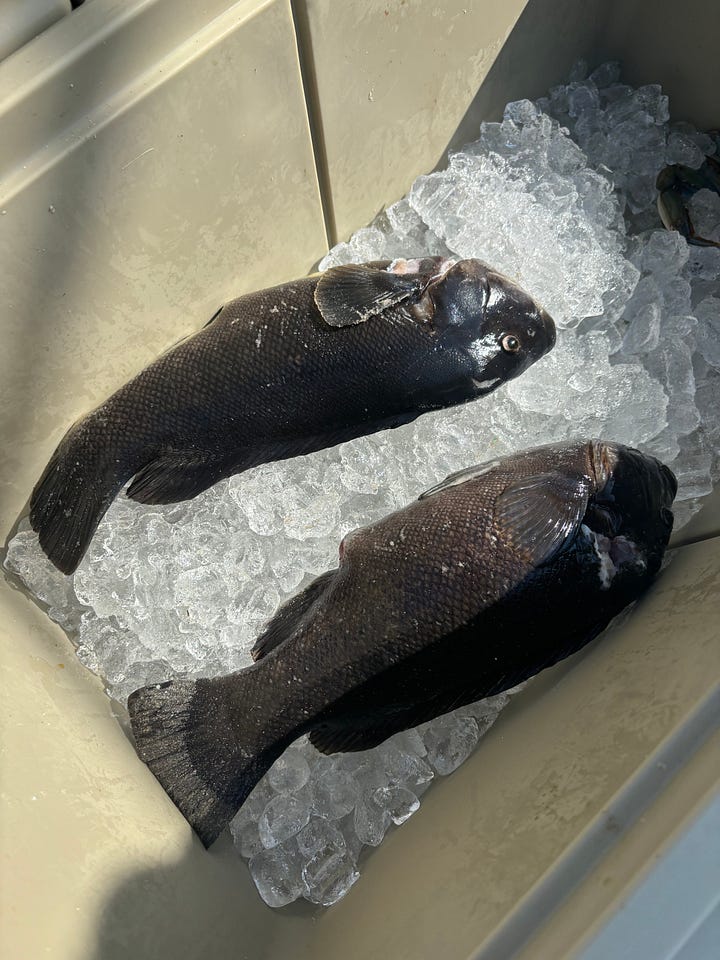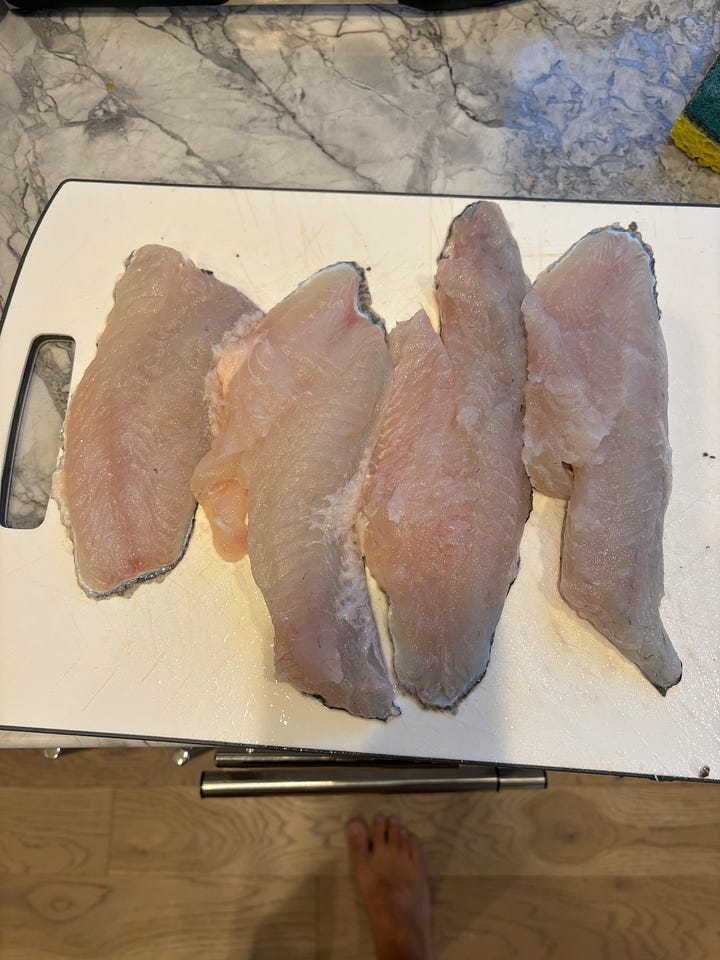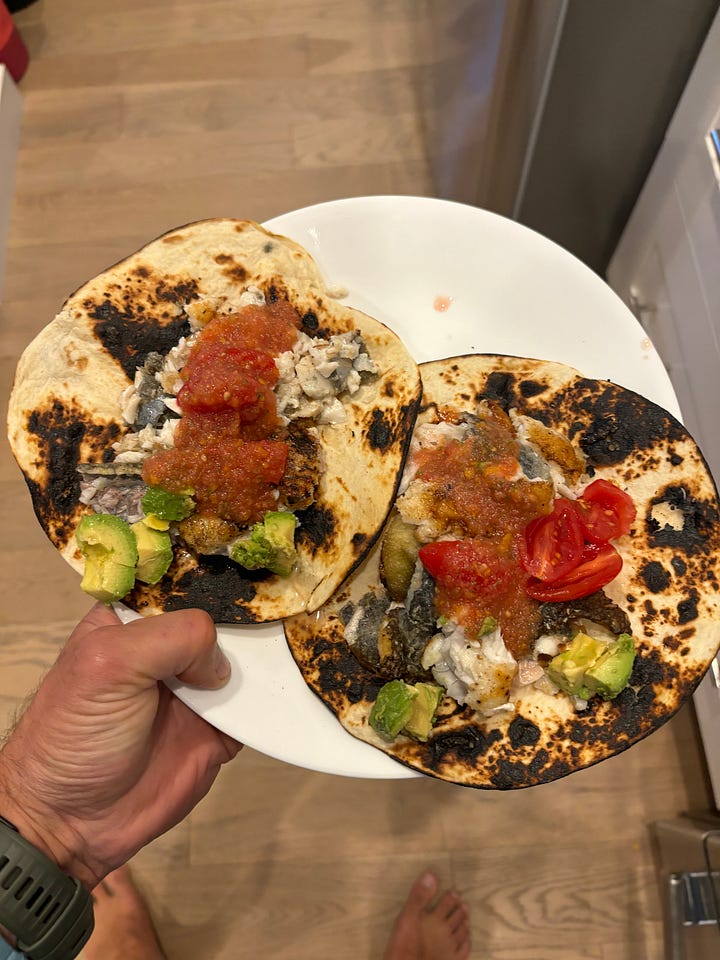Duck Camp, a hunting brand, has an advertising campaign this fall reminding us that “vicariously is a terrible way to live.” I like that advice. Rather than scrolling through endless feeds, awash in the experiences of others, I’d much prefer to actually get out there and experience something myself. Which is why, of course, last summer — after nigh on a decade of talking about it — I finally went out and got myself a speargun, some fins, a mask and wetsuit, and lumbered out into the salt up and down the Eastern Seaboard trying to catch some fish1.
Those of you who have been following along for awhile — or those who are here at the recommendation of
from — know how that first season went2. When I put my wetsuit away last September, my illustrious spearfishing successes amounted to one undersized and under-clawed lobster, zero fish3, and one bemused wife. I loved every second of it. As I’ve written about with hunting before, there’s a feeling of sublime fulfilment when you’re out in nature, alone and disconnected. Being underwater introduces a new element to the mix, being in an alien environment, limited in so many ways and perception dulled4. So, with this summer filled with beach trips, I was stoked each time to wade into the blue — and, obviously, was filled with undeserved confidence.Our first foray back in the water went about well as expected. On Fathers’ Day, Steady and I suited up in wetsuits and made the long trek down the beach in Gloucester towards the water and an island we’d read held lobsters and fish, and maybe even some scallops. As we got ready to enter the water, a lifeguard walked over.
“What are you guys doing?”
“A little spearfishing, sir. Hoping to check out the island, maybe get some lobsters.”
“Have you guys done this before?”
“Plenty of times. We’ve even been confused for pros!”
“Whatever. Be safe and if anything goes wrong, just wave your flippers in the air. The Coast Guard should be able to get out here in about an hour.”
Kicking towards the rocks and still basking in the lobstering success5 of last year, I immediately had my eyes out for crustaceans. Steady, as he’s wont to do, was hunting flounder in the sand. For two hours, neither of us saw anything worth grabbing — though Steady did catch sight of a few stripers6. On my last dive, I caught sight of a claw peaking from under a rock. I swam down and got a look at the biggest lobster I’ve ever seen. I kid you not when I say that the lobster’s carapace was seventeen inches long, with claws like tree trunks. Eyes like steel, cold and hard; antennae, a shock of red like the fires of hell.
Naturally, I tried to pick it up.
And I did. But, given the enormity of the beast, even grabbing behind its back, it still was able to reach around and grab hold of my thumb with its pincer claw. I exhaled an expletive of bubbles and kicked to the surface, shouting to Steady.
“Steady! I need help! It got me! It got me!”
He swam over frantically and his eyes widened. After realizing I wasn’t in mortal danger — and putting his flipper back on (“no need to flag the lifeguard!”) — he helped me pry the claw off my now throbbing hand. A quick measurement confirmed what I suspected: that it was well-over legal size — and was a female loaded with eggs, also a no-no — so I chucked the creature back into the shadowy depths. We then swam back to shore and made the long walk back up the beach7.
We dove that same spot a few more times with not much better luck, but were still filled with irrational exuberance as we drove out to the northern tip of Long Beach Island in New Jersey a few months later. Plodding the quarter-mile over the sand to the ocean — feet burning, sweating in 5mm wetsuits, and wishing we had a camel — we planned our dive. We figured we’d cruise along an old jetty looking for flounder, maybe picking up a wayward blue crab or two along the way. As we approached the water, we were delighted to see calm seas and light wind.
On my first dive, I saw a flash, looked up, and saw the ugly mug of not a flounder, but a tautog. Also known as a blackfish, tog are ugly fish with rows and rows of teeth. They feed on mollusks and crabs — and, according to the 1920 edition of the Encyclopedia Americana is “one of the best table fishes of the American coast.”
“I think I just saw a tog!”
“Me too!”
There’s a moment in any pursuit — but specifically ones like hunting and fishing — where the challenge shifts from theoretical to practical. Not having been on a multitude of fish before, the hardest part about spearfishing was finding something to spearfish. But now, with fish around us — and lots of them — all of sudden we were faced with the very real prospect of firing a steel spear shaft into one. The question becomes not where are the fish, but instead, how do I get close enough to make a good shot?
This is the question, that challenge, that makes the experience fun. It’s what lets you shift from the vicarious to the personal; it’s how you walk the knife’s edge of the hunt.
Steady and I pondered this question for the next four days. We try all manner of approaches — we spotted and stalked, we laid up and waited, we bumped and dumped — but sometimes, it’s better to be lucky than good. This time of year, New Jersey has a one-tog limit, and we finished the trip with seven fish in the cooler: four for me and three for Steady.
On the first day, Steady dropped his dive knife braining his fish, so the next day, we stopped at a local bait shop to see if he could pick up a new one. Talking to the owner, we learned there was a spearfishing tournament going on. We looked at the leaderboard and saw the biggest tog caught so far was only at 18.5” inches — and we were within spitting distance after our fish day. With that target in mind, we dove the remainder of the trip waiting for the big one.
Unfortunately for us, conditions were never as good as they were the first day. We struggled with low visibility, strong swells, and bad tides. We didn’t end up spearing the island record tog. But, still, each day, we managed to put fish in the cooler — and that in itself was beyond satisfying. On the last day, with arguably the worst conditions, Steady and I both killed good fish using the strategies and tactics we learned the previous days8. The feeling of accomplishment after that was almost as nice as the fish tacos we enjoyed that evening9.
My wetsuit is put away now, speargun un-banded and in storage. My mind has already shifted fully to archery season, from silver flashes to whitetails. But what’s cool about this hunting thing is that there are lessons everywhere. After a summer focusing on underwater targets, I’m reminded of the importance of patience, of hunting the right spot, of making good shots. Even though they are different disciplines, getting better at one makes you better at all the rest.
At the end of the day, you can consume as much media as you’d like — books, podcasts, videos, website and magazine articles — but in order to really figure it out, you need to get out there and do it yourself. And nobody is stopping you but you.
You just can’t do it vicariously10.
Go out and catch several flaky, white fish — tautog, snapper, grouper, flounder, fluke, or seabass would all work well — either by rod and reel or by spear11. Gut and filet them — throwing the organic material12 into the nearest body of salt water — and get them on ice.




When you’re ready to eat, pat the filets dry and lighten season them with salt and pepper then dust with flour. Heat a cast-iron pan with your cooking oil of choice — we used butter here — and pan-sear the fish until cooked through, flipping once or twice, about 3-4 minutes per side13. Remove from the heat and roughly chop into bite sized pieces.
Place these on warm tortillas and top with fresh salsa14, cabbage slaw, avocado, and any other taco toppings you desire.
So that’s it folks. As of this weekend, we’re officially into fall. Deer season is just a few weeks away. Pumpkins are out, cider donuts are on sale15. The Family CWD will celebrate with our first weekend home and without obligations16 since Memorial Day, and I, for one, couldn’t be more excited. I hope that you, too, have something to look forward to this weekend.
However you spend it, may you embrace it and not just experience it through your screen. As the folks at Duck Camp keep reminding me, the world is too exciting to live it vicariously.
We’ll see you here next week.
I even convinced Uncle Steady to go all-in, too.
I’m not even sure I saw a fish underwater, truth be told.
And, counter intuitively, also heightened — a paradox I can’t quite describe in words; you need to experience it yourself.
If you can call it that.
Not spearable in Massachusetts.
Each time we did this, down the packed beach, in front of families and astonished bathers, wearing wetsuits, holding all manner of fins and flippers and masks and buoys and ropes and spearguns, our wives pretended that they were single moms.
In retrospect, the conditions were probably about the same as they were when we dove that spot the previous year, when we came home with zero fish. The difference, of course, was this year, we knew where the fish hung out, how they reacted, and had a sense of how to get them. That experience is something you can’t learn vicariously — you can watch videos, read how-to articles, but, at the end of the day, you need to actually go out there and see the fish moving in order to bring them home on a cooler.
I was reading Tony Peterson’s book Bowhunting Public Land Whitetails and he talks about how he doesn’t hunt — on public land at least — for trophy bucks, but instead hunts for whatever legal deer gets his heart pumping when it walks by his stand. I like that approach, and I like it even more for spearfishing.
I suppose you could also buy them from your fishmonger, or, if you have to, from the grocery store. Just make sure whatever you buy is wild-caught.
And ONLY the organic material!
This will depend heavily on the size of your fish.
Here’s a quick recipe I use a lot: roughly chop two to three tomatoes, half a cucumber, and half an onion. Put those in a blender with salt, pepper, cumin, and a squeeze or two of lime juice. Blend until your desired consistency and then add more seasoning to taste.
If you like cider donuts, by the way,
wrote a terrific piece on them recently in her newsletter .Well, almost without obligations.









That last part is so true. One of my most influential mentors would ask, “do you know or do you understand?”. His point being: you can “know” a lot from reading, watching and listening. You only gain “understanding” when you’ve experienced and put it into practice. A nitpick on two similar words, but that has stuck with me!
On this one, I chose to live it vicariously